wikiHow is a “wiki,” similar to Wikipedia, which means that many of our articles are co-written by multiple authors. To create this article, 11 people, some anonymous, worked to edit and improve it over time.
This article has been viewed 232,404 times.
Learn more...
If you want to make your nose bleed without hurting yourself, you'll need to create a fake nosebleed with fake blood. Fake blood is highly adaptable and can be used to create a range of dried and dripping nosebleeds.
Steps
Method One: Smeared or Dried Nosebleed
-
1Make some fake blood. For this particular technique, you'll make a chocolate syrup based blood. By tinting the syrup with red dye and laundry detergent, you can create a brownish-red solution that mimics the appearance of real blood that has been out of the body and exposed to air for an extended period of time. The consistency of this blood also makes it easy to smear.[1]
- In a small bowl, mix 2/3 cup (150 ml) chocolate syrup with 1/3 cup (75 ml) concentrated liquid laundry detergent until well combined.
- Pour in 4 to 6 tsp (20 to 30 ml) of red food coloring, adding as much or as little as needed to create your desired hue.
-
2Apply the blood below and around your nose.[2] Dip the tip of a cosmetic sponge wand into your fake blood. Brush the blood onto your face, focusing on the area between your nose and your mouth. Cover the entire area, but make sure that the blood fans out from the nose toward the sides of your mouth. You should also apply blood to the bottom of the nose, directly along the sides of the nostrils.
- A small, clean paintbrush could be used instead of a cosmetic sponge wand, if necessary.
- Stand in front of a mirror as you apply the fake blood.
- Play around with it a bit. There is no one pattern to use when creating a fake nosebleed, so you'll have to test a few looks out before deciding how you want the nosebleed to look.
- Do not use straight lines. A real nosebleed is messy, so your fake blood needs to be applied accordingly.
- You can also apply a little blood to the sides and tip of your nose if you want to create a more extreme nosebleed. Focus on the nostril area, though, and avoid getting blood higher up on the bridge.
Advertisement -
3Intensify the nosebleed. Since real nosebleeds are often so messy, you may need to extend the fake blood past the area of your nose in order to make it more believable. You can do so by applying a smear to one side of your mouth and a few drops to your neck.
- Gauge which side of your nosebleed currently looks heavier. Brush on more fake blood around your mouth on that side of the face only, leaving the other side of your mouth untouched.
- The blood should cover the corner of your mouth and just below your bottom lip.
- Smear more blood downward and slanted off toward the side of your face, stopping at the base of your neck.
- Apply a few dabs of blood to the base of your neck on the same side of your face. These dabs need to look like dried drips of blood that fell off from the trail of blood already along the side of your face.
-
4Dry the blood with a hair dryer, if desired. If you want the blood smears to look fresh, you can wear them as they already are. If you want to create the appearance of a nosebleed that has already dried, however, use a hair dryer set to low heat to dry the fake blood until it no longer feel wet to the touch.
- Hold the hair dryer from a distance and point the stream of air directly against the blood smear. Avoid drying the smear from an angle since doing so could change the appearance of the smear.
- Your fake nosebleed should be complete at the conclusion of this step.
Method Two: Dripping Nosebleed
-
1Make some fake blood. Dripping blood is fresh and oxygenated, so you need a fake blood recipe that is more watery and a bit brighter than the fake blood used for dried smears. Light corn syrup can accomplish this effect. Adding corn starch thickens the mixture to the right consistency, and the addition of laundry soap makes the blood less likely to stain.
- In a small bowl, mix together 2/3 cup (150 ml) light corn syrup, 1/3 cup (75 ml) warm water, 3 to 5 tsp (15 to 25 ml) red food coloring, 2 to 3 drops blue or green food coloring, 5 Tbsp (75 ml) cornstarch, and a squirt of liquid laundry soap. Continue mixing until evenly combined into a smooth mixture.
- Note that you can adjust the amount of red food coloring as needed to achieve your desired shade.
- If the blood seems too thin, add more cornstarch. If it seems too thick, add more water.
-
2Fill an eye dropper with the blood. Squeeze the tip of a clean, empty eye dropper and dunk the mouth of the dropper into your fake blood. Release the tip to draw the blood into the body of the dropper.
- A syringe without a needle could also work if you do not have an eye dropper. Essentially, you just need a tool that you can use to control the application of fake blood. That tool must have a mouth that is small enough to fit into one nostril, however.
-
3Squeeze the blood out at the base of your nostril. Hold your heat straight and place the mouth of the dropper at the base of one nostril. Slowly squeeze the bulb so that fake blood comes out in a mild trickle. The blood should pour down from the base of your nostril to your mouth in an even stream.
- To make the process easier, use a mirror when applying the blood.
- Note that you may not use all of the fake blood inside the dropper. You only need to use enough fake blood to create one steady trail.
- Do not squirt the blood directly into your nostril. The tip of the dropper should be on the outside of your nostril, at its very base. The body of the dropper should be pointed up and slanted off the one side.
- Only apply the fake blood to one side of your nose for a more convincing nosebleed.
- The conclusion of this step marks the end of this method.
Method Three: Nosebleed on Command
-
1Make some fake blood. The fake blood you'll need to use for this technique is similar to the blood you might make for a standard running nosebleed, but you need to skip the addition of laundry detergent since this blood will be going directly inside your nose.
- In a small bowl, thoroughly whisk or mix together 1 cup (250 ml) light corn syrup, 1 Tbsp (15 ml) water, 2 Tbsp (30 ml) red food coloring, 2 to 3 drops of green or blue food coloring, and 2 Tbsp (30 ml) of cornstarch. Continue mixing until the cornstarch dissolves.[3]
- Add more cornstarch for thicker blood and more water for thinner blood. Note that slightly thickened blood might be easier to hold in your nose, but it still needs to be watery enough to drip down naturally.
- If the blood looks a little too red to be realistic, add a few more drops of blue or green food coloring to create a subtle brown tint.
-
2Fill an eye dropper with the blood. Squeeze the bulb of the dropper to expel all the air in the tube and dip the tip into your fake blood. Release the bulb so that fake blood is drawn into the body of dropper.
- A syringe or similar tool could be used instead of the dropper, but the tip must be small enough to fit into one of your nostrils.
-
3Tilt your head back and squeeze the blood into your nose. Stand in front of a mirror and tilt your head back slightly, just enough to make your nostrils visible in the mirror. Insert the tip of the dropper into your nostril and slowly squeeze the bulb, releasing the fake blood into your nose.
- This step should be done simultaneously with the following step.
- Do not inhale sharply as you squeeze the fake blood into your nose.
-
4Slowly draw air into your nose.[4] Take slow, shallow inhales through your nose. Sniff enough to draw the blood into the upper part of your nostril without inhaling too sharply and drawing it further into your sinus cavities.
- This part will likely take some practice to master. A little too much sniffling makes it look like you have a runny nose. Sniffing too much too quickly can cause the fake blood to escape into your sinus passages, which could cause a harsh stinging sensation. Not sniffling enough will cause the blood to release from your nose prematurely.
- You will need to continually breathe in to keep the fake blood in place, so even if you master the technique, you can only hold it there for a minute or so.
-
5Exhale through the nose. When you are ready to create your nosebleed, stop inhaling and gently exhale through the nose. Without the suction provided from your inhale, the blood should be released and should come trickling out of your nostril in a steady, believable stream.
- Do not exhale with too much force since doing so could cause the fake blood to gush out of your nose too quickly.
- The completion of this step marks the completion of this method.
Additional Fake Blood Recipes
-
1Use tropical fruit punch. Select a fruit punch with a deep red hue. As is, this recipe works well for any dripping nosebleed technique, but you can also add a little more cornstarch if you want to make it thick enough for smears or dried blood.
- Combine 1/2 cup (125 ml) tropical fruit punch with 1 cup (250 ml) corn syrup, 2 Tbsp (30 ml) red food coloring, 1 Tbsp (15 ml) chocolate syrup, 2 Tbsp (30 ml) cornstarch, and 1 Tbsp (15 ml) powdered cocoa. Blend the ingredients in a blender for about 10 seconds, or until evenly mixed.
- Note that every fruit punch varies slightly in shade, so you may need to adjust the color. Add more red food coloring to brighten the blood or more chocolate syrup to dull the blood.
-
2Create fake blood using coffee. Brewed coffee provides a strong enough brown tint to realistically dull the shade of your fake blood. This recipe is best used for dripping nosebleeds, but if you add more cornstarch, you can thicken it enough to use for smears.
- In a blender, combine 1/2 cup (125 ml) brewed coffee, 1 cup (250 ml) light corn syrup, 2 Tbsp (30 ml) red food coloring, and 2 Tbsp (30 ml) cornstarch. Blend for 10 seconds or until evenly mixed.
Community Q&A
-
QuestionHow would I induce an all natural nose bleed?
 Community AnswerGo to the nearest marble building. Stand next to it and observe it for a second. Than smack your head against the wall. All natural nose bleed. In all seriousness, though, this is a really bad idea.
Community AnswerGo to the nearest marble building. Stand next to it and observe it for a second. Than smack your head against the wall. All natural nose bleed. In all seriousness, though, this is a really bad idea. -
QuestionCan I buy blood?
 Community AnswerYes, you can buy fake blood online easily.
Community AnswerYes, you can buy fake blood online easily. -
QuestionIs it safe to put laundry detergent in my nose. If not, what can I use?
 Community AnswerLaundry detergent is toxic. NEVER put it in your eyes, nose, or mouth. See the article for some alternatives.
Community AnswerLaundry detergent is toxic. NEVER put it in your eyes, nose, or mouth. See the article for some alternatives.
Warnings
- Avoid using toxic or semi-toxic fake blood around your nose.⧼thumbs_response⧽
- Do not attempt to make your nose actually bleed. There is no way to guarantee that you can produce a real nosebleed without hurting yourself.⧼thumbs_response⧽
- Do not fill your nose with any fake blood containing laundry soap.⧼thumbs_response⧽
Things You'll Need
Smeared or Dried Nosebleed
- Small bowl
- Whisk
- 2/3 cup (150 ml) chocolate syrup
- 1/3 cup (75 ml) concentrated liquid laundry detergent
- 4 to 6 tsp (20 to 30 ml) red food coloring
- Cosmetic sponge wand
- Hair dryer
Dripping Nosebleed
- Small bowl
- Whisk
- 2/3 cup (150 ml) light corn syrup
- 1/3 cup (75 ml) warm water
- 3 to 5 tsp (15 to 25 ml) red food coloring
- 2 to 3 drops blue or green food coloring
- 5 Tbsp (75 ml) cornstarch
- Liquid laundry soap
- Eye dropper
Nosebleed on Command
- Small bowl
- Whisk
- 1 cup (250 ml) light corn syrup
- 1 Tbsp (15 ml) water
- 2 Tbsp (30 ml) red food coloring
- 2 to 3 drops green or blue food coloring
- 2 Tbsp (30 ml) cornstarch
- Eye dropper
References
About This Article
To fake a nose bleed, make some fake blood by mixing together light corn syrup, warm water, red and blue food coloring, and some cornstarch. Once this is mixed well, pour it into an eye dropper or a syringe with a tip that will fit into your nostril. Then, tilt your head back and squeeze the blood into your nose, inhaling slowly. When you are ready to start your fake nosebleed, slowly exhale through your nose. To learn how to make a smeared or dried nosebleed, read on!
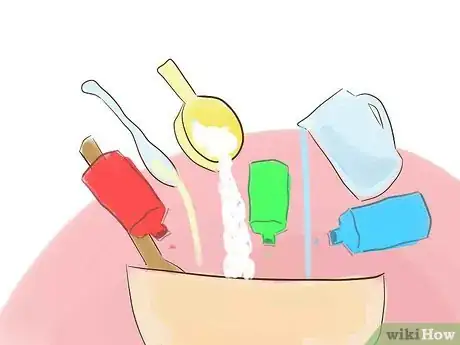
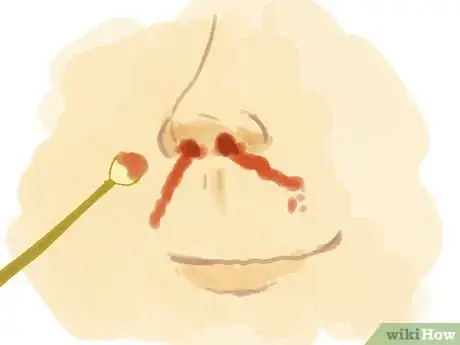

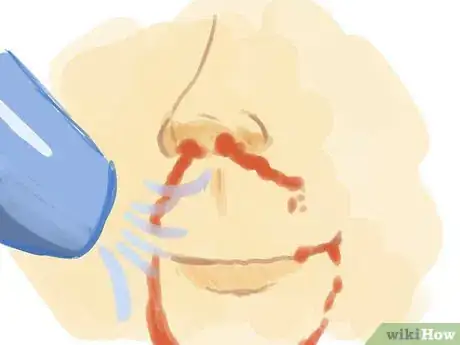
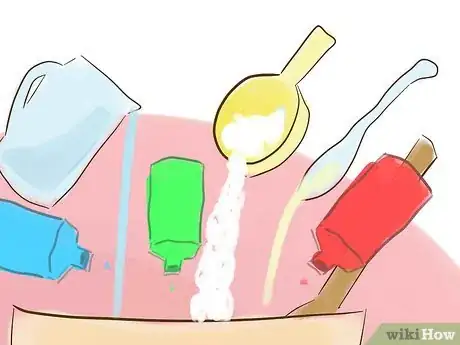
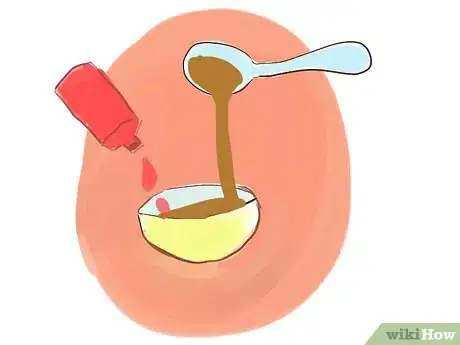
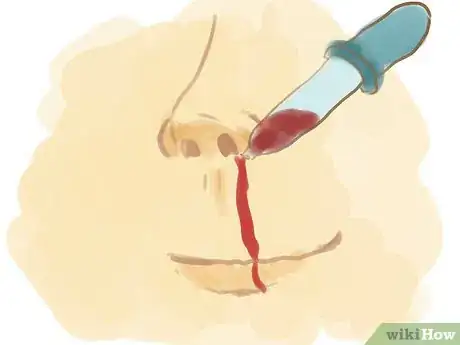
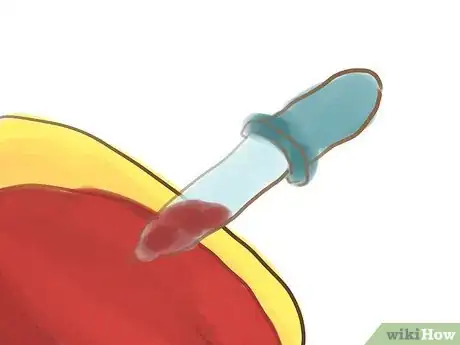
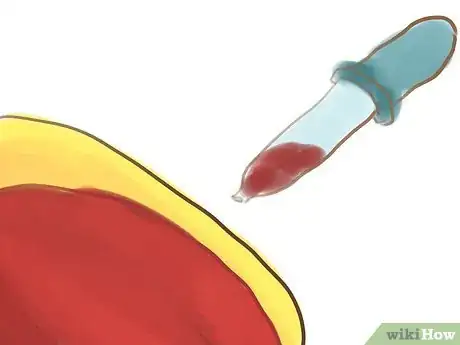
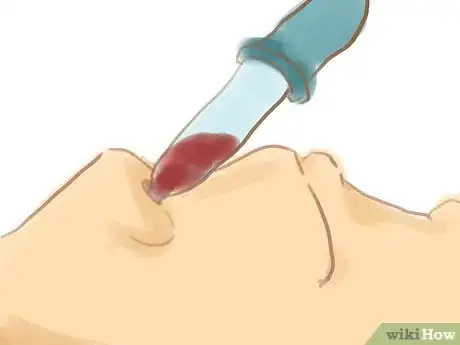
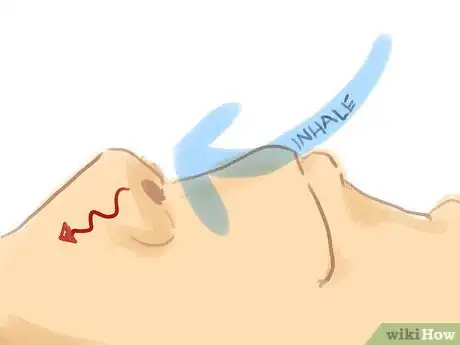
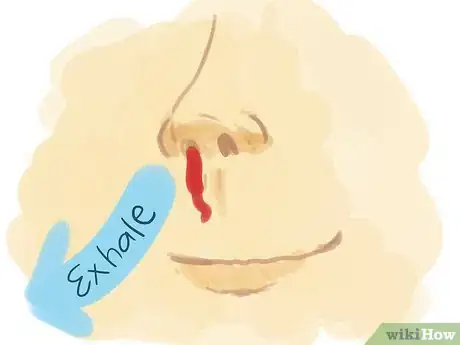
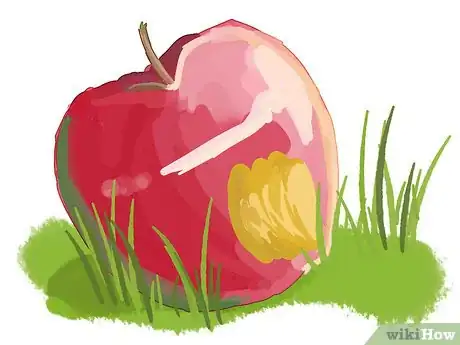

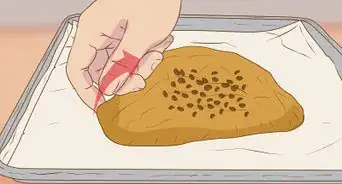
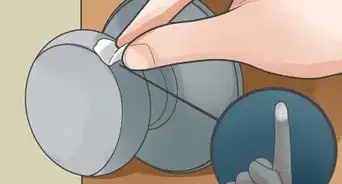
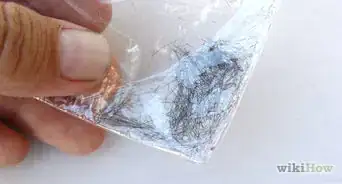







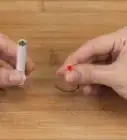
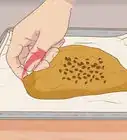

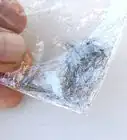



































Medical Disclaimer
The content of this article is not intended to be a substitute for professional medical advice, examination, diagnosis, or treatment. You should always contact your doctor or other qualified healthcare professional before starting, changing, or stopping any kind of health treatment.
Read More...